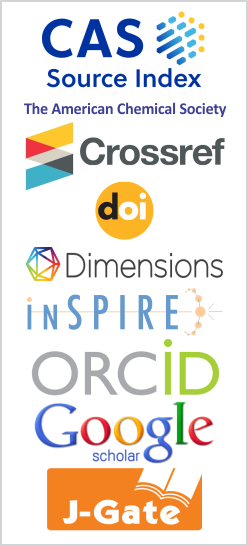Electron Acceleration by a Radially Polarized Laser Pulse in an Azimuthal Magnetic Field
DOI:
https://doi.org/10.26713/jamcnp.v5i2.810Keywords:
Laser acceleration, Radially polarized laser beamAbstract
Laser acceleration by radially polarized laser beams takes advantage of the strong longitudinal electric field component at the beam centre. When the laser field intensity is sufficiently high, it can push electrons initially at rest at the beam waist outside the Rayleigh zone and accelerate them to relativistic velocities along the laser axis. To obtain the best results in terms of electron dynamics and energy estimation, we suggest that the electrons could be accelerated to a very high energy level by the radially polarized laser pulse. The additionally used azimuthal magnetic field helps to retain the electron energy during acceleration. In this paper, we describe the electron energy scales with laser power and we explain how the laser beam parameter and the magnetic field both can be optimized for maximal acceleration.Downloads
References
M. Y. Yu, W. Yu, Z. Y. Chen, J. Zhang, Y. Yin, L. H. Cao, P. X. Lu and Z.Z. Xu, Phys. Plasmas 10, 2468 (2003).
K.P. Singh, Phys. Plasmas 11, 1164 (2004).
C. Gahn, G. Tsakiris, A. Pukhov et al., Phys. Rev. Lett 83, 4772 (1999).
G. D. Tsakiris, C. Gahn and V. K. Tripathi, Phys. Plasmas 7, 3017 (2000).
M. G. Haines, Phys. Rev. Lett 87, 135005 (2001).
K.P. Singh, Phys. Plasmas 11, 3992 – 3996 (2004).
F. V. Hartemann, High-Field Electrodynamics, CRC Press (2001).
K.P. Singh, J. Opt. Soc. Am. B 23, (8) (August 2006), 1650.
X. He, R. X. Li, B. Shuai, X. C. Ge and Z. Z. Xu, Phys. Plasmas 12, 073101 (2005).
A. Bahari and V. D. Taranukhin, Quantum Electron. 34, 129 (2004).
F. He, W. Yu , P. Lu, H. Xu, L. Qian, B. Shen, X. Yuan, R. Li and Z. Xu, Phys. Rev. E 68, 46407 (2003).
K. P. Singh, J. Appl. Phys. 100, 044907 (2006).
F. V. Hartemann, S. N. Fochs, G. P. L. Sage, N. C. Luhmann, Jr., J. G. Woodworth, M. D. Perry, Y. J. Chen and A. K. Kerman, Phys. Rev. E 51, 4833 (1995).
G. V. Stupakov and M. S. Zolotorev, Phys. Rev. Lett. 86, 5274 (2001).
P. X. Wang, Y. H. Ho, X. Q. Yuan, Q. Kong, N. Cao, L. Shao, A. M. Sessler, E. Esarey, E. Moshkovich, Y. Nishida, N. Yugami, H. Ito, J. X. Wang and S. Scheid, J. Appl. Phys. 91, 856 (2002).
G. Malka, E. Lefebvre and J. L. Miquel, Phys. Rev. Lett. 78, 3314 (1997).
H.S. Ghotra and N. Kan, Phys. Plasmas 23, 053115 (2016).
Downloads
Published
How to Cite
Issue
Section
License
Authors who publish with this journal agree to the following terms:- Authors retain copyright and grant the journal right of first publication with the work simultaneously licensed under a CCAL that allows others to share the work with an acknowledgement of the work's authorship and initial publication in this journal.
- Authors are able to enter into separate, additional contractual arrangements for the non-exclusive distribution of the journal's published version of the work (e.g., post it to an institutional repository or publish it in a book), with an acknowledgement of its initial publication in this journal.
- Authors are permitted and encouraged to post their work online (e.g., in institutional repositories or on their website) prior to and during the submission process, as it can lead to productive exchanges, as well as earlier and greater citation of published work.




